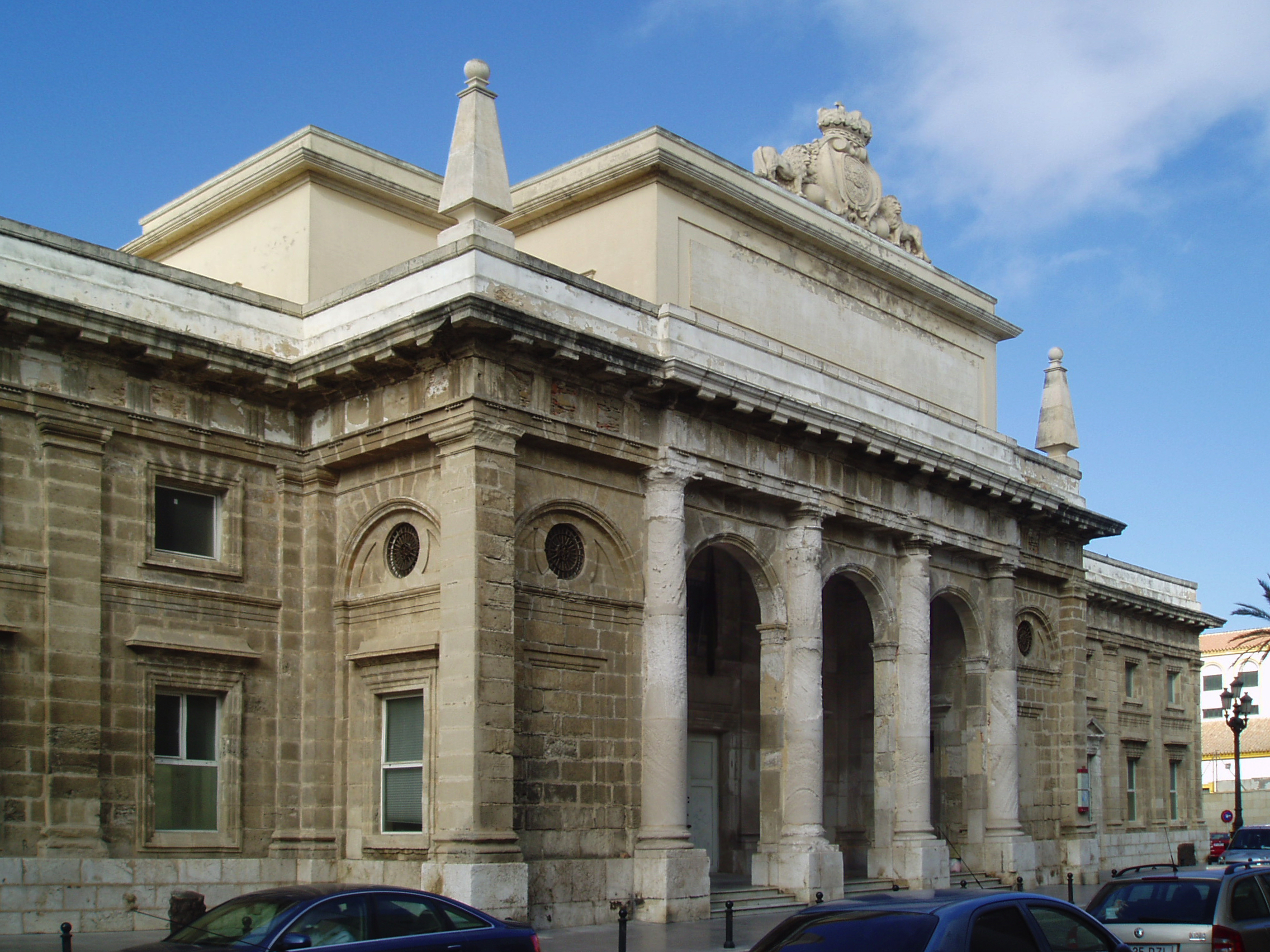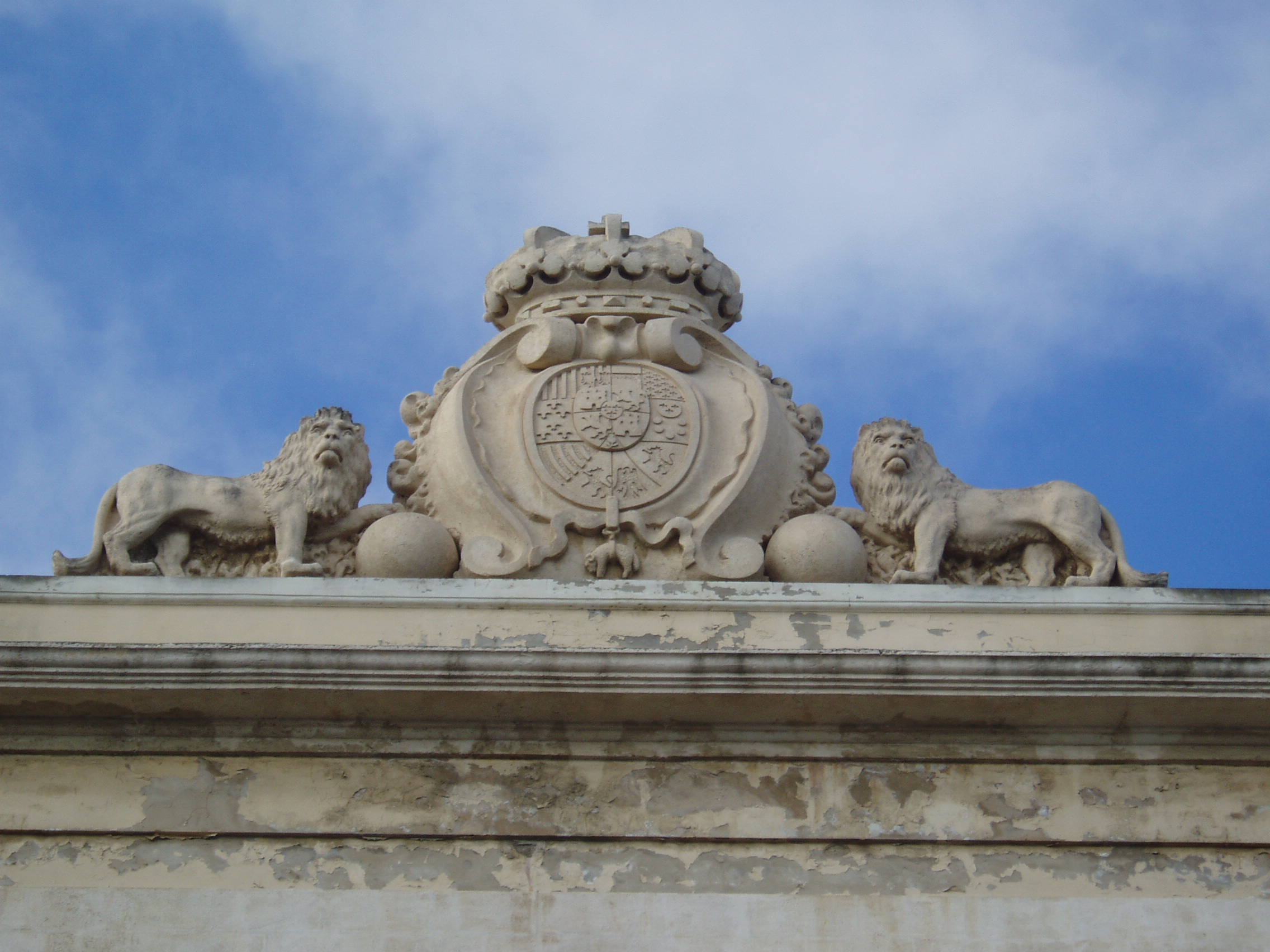Cárcel Real (Cádiz) on:
[Wikipedia]
[Google]
[Amazon]

 The Cárcel Real (Spanish: Royal Prison) is a historical building in
The Cárcel Real (Spanish: Royal Prison) is a historical building in
' odia el delito, compadece al delincuente' ''se podría pensar que habría sido construido para un museo o centro literario."''
Cádiz
Cádiz ( , , ) is a city in Spain and the capital of the Province of Cádiz in the Autonomous communities of Spain, autonomous community of Andalusia. It is located in the southwest of the Iberian Peninsula off the Atlantic Ocean separated fr ...
, southern Spain
Spain, or the Kingdom of Spain, is a country in Southern Europe, Southern and Western Europe with territories in North Africa. Featuring the Punta de Tarifa, southernmost point of continental Europe, it is the largest country in Southern Eur ...
, an example of Neoclassical architecture
Neoclassical architecture, sometimes referred to as Classical Revival architecture, is an architectural style produced by the Neoclassicism, Neoclassical movement that began in the mid-18th century in Italy, France and Germany. It became one of t ...
.
History
In 1792, the city of Cádiz decided to replace its inadequate, poorly situated, and poorly constructed prison. The new, larger prison would be in a place with better air. Torcuato Benjumeda, the most representative architect of Cádiz at that time, designed the building. This was at the time neoclassicism was beginning to eclipseBaroque architecture
Baroque architecture is a highly decorative and theatrical style which appeared in Italy in the late 16th century and gradually spread across Europe. It was originally introduced by the Catholic Church, particularly by the Jesuits, as a means to ...
in Spain. As Spain entered its long economic decline, the more elaborate Baroque was seen as decadent and in poor taste. The cost of construction was 3.5 million Spanish real
The ''real'' (English: /ɹeɪˈɑl/ Spanish: /reˈal/) (meaning: "royal", plural: ''reales'') was a unit of currency in Spanish Empire, Spain for several centuries after the mid-14th century. It underwent several changes in value relative to oth ...
es.
Although Benjumeda's plans are dated 1794, they almost certainly were backdated, because he signed with the title ''"Académico de mérito"'', which he was not granted until 1807. The city of Cádiz itself is referred to as ''"Muy Heroica"'', a title it was conceded in 1816 as a result of the Peninsular War
The Peninsular War (1808–1814) was fought in the Iberian Peninsula by Kingdom of Portugal, Portugal, Spain and the United Kingdom of Great Britain and Ireland, United Kingdom against the invading and occupying forces of the First French ...
(Spanish War of Independence).
The building opened for use in 1836, at which time a large portion of it had been completed under the leadership of architect Juan Daura. At that time the last portion, closest to the sea was incomplete; indeed it would not be completed until a rehabilitation in 1990. That last project was directed for the Ministry of Justice by J. Montes Deza, adapting the building for use as a courthouse, and saving it from a state of near-ruin. Following the original plans, he completed the final portion of the building and installed a rectangular attic at the top of the projecting principal façade, with a large shield and two pinnacles on the sides.
Description
The building is rectangular, by in size, and perfectly symmetrical in the Neoclassical style. It is organized around a square central courtyard and two smaller rectangular courtyards, which are located to the sides. The cells and other facilities are distributed around these. The building is two stories high, with a projecting mass at the center of the principal façade. Tuscanpilasters
In architecture, a pilaster is both a load-bearing section of thickened wall or column integrated into a wall, and a purely decorative element in classical architecture which gives the appearance of a supporting column and articulates an ext ...
, of the giant order
In classical architecture, a giant order, also known as colossal order, is an order whose columns or pilasters span two (or more) storeys. At the same time, smaller orders may feature in arcades or window and door framings within the storeys that ...
(banked on a base), frame the openings. The wide windows of the lower floor have a simple horizontal dust guard, which becomes concave at its lower ends. Over the pilasters is an entablature
An entablature (; nativization of Italian , from "in" and "table") is the superstructure of moldings and bands which lies horizontally above columns, resting on their capitals. Entablatures are major elements of classical architecture, and ...
, with a frieze
In classical architecture, the frieze is the wide central section of an entablature and may be plain in the Ionic order, Ionic or Corinthian order, Corinthian orders, or decorated with bas-reliefs. Patera (architecture), Paterae are also ...
of triglyph
Triglyph is an architectural term for the vertically channeled tablets of the Doric frieze in classical architecture, so called because of the angular channels in them. The rectangular recessed spaces between the triglyphs on a Doric frieze are ...
s and, below them, three gutta
A gutta (Latin pl. guttae, "drops") is a small water-repelling, cone-shaped projection used near the top of the architrave of the Doric order in classical architecture. At the top of the architrave blocks, a row of six ''guttae'' below the narro ...
e.
The projecting mass at the center of the principal façade has four terraced Tuscan columns, as well as twinned Tuscan pillars at the ends. On the two shorter sides of the projecting mass, over the bays of the lower floor (and delineated by pilasters), are several blind semicircles, over which an oculus is inscribed. An inscription near the mean entrance reads ''"odia el delito, compadece al delincuente"'' ("hate the crime, pity the criminal"), a quotation from Concepción Arenal
Concepción Arenal Ponte ( Ferrol, 31 January 1820 – Vigo, 4 February 1893) was a graduate in law, thinker, journalist, poet and Galician dramatic author within the literary Realism and pioneer in Spanish feminism.
Born in Ferrol, Galicia, ...
.
Enrique Romero de Torres in his ''Catálogo Monumental de España - Provincia de Cádiz'', considered the building to be "the most architecturally tasteful civil building in Cádiz" and added, "if it were not for the legend already cited Hate the crime, pity the criminal' one could think to have been constructed for a museum or a literary center".''"si no fuera por la leyenda antes citada 'Notes
{{DEFAULTSORT:Carcel Real Buildings and structures in Cádiz Prisons in Spain Neoclassical architecture in Andalusia